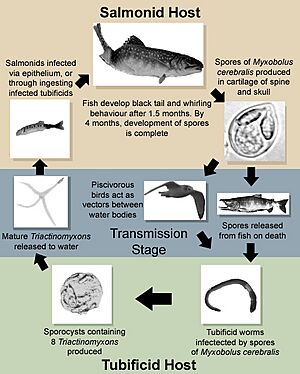Myxobolus cerebralis facts for kids
Myxobolus cerebralis is a tiny Myxozoan parasite that causes a serious fish disease called whirling disease. This disease mainly affects young fish like salmon and trout. It makes them swim in circles, which is why it's called "whirling."
This parasite is a big problem for fish farms and wild fish groups around the world. In the last 100 years, it has spread to many countries. These include most of Europe (like Russia), the United States, and South Africa. Scientists found out in the 1980s that M. cerebralis needs to live inside a special worm before it can infect a fish. It gets into both the fish and the worm by making a small hole and putting part of itself inside.
Whirling disease hurts young fish the most. It can damage their bones and nerves. Fish with the disease cannot swim very well. They "whirl" or spin instead of swimming straight. This makes it hard for them to find food and escape from danger. Dealing with M. cerebralis costs a lot of money, more than most other parasites in its group. But don't worry, people do not get sick with whirling disease; only fish do.
Contents
Understanding Whirling Disease
What is Myxobolus cerebralis?
Myxobolus cerebralis is a very small living thing that lives off other creatures. It is a type of Myxozoan parasite. This parasite causes a disease that mostly affects young salmon and trout. It lives inside the fish and damages their bones and nerves.
How the Parasite Spreads
This parasite has spread widely across the world. It is now found in many parts of Europe, the United States, and South Africa. It has been spreading for over 100 years. For the parasite to spread, it needs to live in two different hosts. First, it lives in a special type of worm. Then, it can infect fish.
Life Cycle of the Parasite
The life of Myxobolus cerebralis is quite interesting because it needs two different hosts to complete its journey.
- First, the parasite lives inside a small aquatic worm.
- When the parasite is ready, it leaves the worm and floats in the water.
- If a fish swims by, the parasite can attach to it.
- It then pokes a tiny hole in the fish and enters its body.
- Inside the fish, the parasite grows and causes the whirling disease.
- When the fish dies, the parasite can then infect more worms, starting the cycle again.
Impact on Fish
Whirling disease has a big impact on fish, especially young ones.
- Fish with the disease often have bent or deformed spines.
- They cannot swim in a straight line. Instead, they swim in circles or "whirl."
- This makes it very hard for them to catch food.
- It also makes them easy targets for predators.
- The disease can lead to many fish dying, which is a problem for both wild fish and those in fish farms.
Images for kids
-
Skeletal deformation in a mature brook trout caused by M. cerebralis infection.
-
M. cerebralis has been reported in Germany (1893), Italy (1954), USSR (1955), including Sakhalin Island (1960), USA (1958), Bulgaria (1960), Yugoslavia (1960), Sweden (1966), South Africa (1966), Scotland (1968), New Zealand (1971), Ecuador (1971), Norway (1971), Colombia (1972), Lebanon (1973), Ireland (1974), Spain (1981) and England (1981)
See also
 In Spanish: Myxobolus cerebralis para niños
In Spanish: Myxobolus cerebralis para niños






